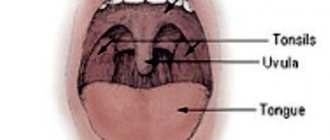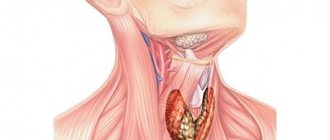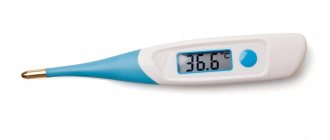People often experience a lump in the throat. Everyone has experienced this feeling at least once in their life. The feeling of a lump in the throat most often occurs without physical reasons, after experiencing stress. At some point, you notice that something is bothering your throat or starting to feel sore.
For some people, this feeling remains for a long time and even begins to cause discomfort when swallowing. In this case, other accompanying symptoms may occur, for example, sleep disturbances, increased levels of anxiety, decreased mood, etc. But there is no need to rush to conclusions and think about the presence of some complex, incurable disease or physical damage.
In the vast majority of cases, this feeling has psychological roots, and treating a lump in the throat is not difficult and responds well to therapy. However, in advanced cases, when it is not treated correctly or the process is prolonged or untreated for a long time, complications develop. Therefore, in order to undergo high-quality therapy and get rid of a lump in the throat, it is necessary to undergo a psychological differential diagnosis.
We carry out full differential diagnosis and treatment, which is completely successful in more than 90% of cases. There are many different options for disruption of higher nervous activity and the formation of sensations of a lump in the throat.
Our slogan is from quality diagnosis to complete recovery!
Find out what may be causing that lump in your throat! When is a complex disorder likely to occur? What to do when you feel a lump in your throat?
What can cause a lump in the throat?
The sensation of a lump in the throat occurs as a result of the occurrence of any disease. However, the most common cases are when a lump in the throat is felt after suffering stress or experiences. The feeling of having a lump in the larynx, if associated with psychological reasons, does not pose a health risk. It is not uncommon for this feeling to go away on its own within ten days or a week. However, when this sensation occurs, discomfort often occurs. Depending on individual characteristics, this inconvenience may be felt in different ways. Incorrect identification of the causes and ignorance of the factors that form this sensation often leads to serious consequences and speculation.
How does a lump in your throat feel?
- lump in throat while eating or after eating;
- sensation of a lump in the larynx throughout the day;
- sore throat and feeling that something is bothering you;
- a lump in the throat seems to interfere with breathing, which often leads to panic;
- a burning sensation or other unpleasant feeling appears in the throat area.
More than 90% of complaints about a lump in the throat are due to so-called psychogenic causes. This symptomatology is often associated with high psycho-emotional or psychophysical overload. In the modern world, we encounter such overloads every day, often several times a day. At work, in transport, in shops, at home. But this feeling does not appear for everyone. Why does this happen and why doesn’t it happen to everyone?
This phenomenon has been well studied, and a competent doctor will always be able to correctly understand and provide assistance, independently or refer you to a specialized specialist. Conditions in which this feeling may appear can occur in both men and women of any age. However, people of the most productive, working age are the most vulnerable. In people between 25 and 50 years of age, these complaints are most common.
Chronic tonsillitis, mucus running down the back of the throat
Daria, Moscow
October 30, 2018
Hello, Doctor! The following problem worries me. For 5 months I have been bothered by mucus running down the back of my throat. The mucus is abundant, white-yellow in color. CT scan of the nose - no pathologies. CBC, biochemistry are normal. There is chronic tonsillitis. An oropharyngeal culture was taken on September 05. 2022, in which Staphylococcus aureus 10^6 COE/tamp was identified. Treatment: June: Rinsing with eucalyptus tincture, a solution of soda and iodine. Irrigation of the throat with Kameton spray. Grammidin. Tsiprolet (3 days). July: Vilprafen Solutab - 1000 mg, 1 tablet. 2 r. per day (5 days). Tonsilotren - 2 tablets. Up to 10 times a day (2 weeks). Gargling with Furacilin solution (10 days). Gargling with chamomile, soda, sage. Polyoxidonium (intramuscular 5 pcs.) August: Amoxiclav - 1 tablet. 1 time per day (6 days). Gargling with Chlorophyllipt solution. Polyoxidonium - 1 tablet. Per day (10 days). September: Tetracycline - 1 tablet. 2 r. per day (7 days). Sextaphage Pyobacteriophage polyvalent - 2 ml. In each nasal passage 2 times a day (10 days). Nasonex - 2 times in each nasal passage, 1 time per day (10 days). Gargling with Chlorophyllipt solution. October: Nasal rinsing with Aqualor Soft 3-4 times a day. Sialor (Protargol) - 2 times in each nasal passage - 2 times a day. Chlorophyllipt oil solution in the nose. Rinse with Chlorophyllipt solution, Chlorhexidine. Irrigation of the throat with Miramistin. Galavit - 1 tablet. 3 times a day (10 days). After all the treatment, improvement was observed for about a week. Then again. Mucus drains copiously every 2-3 hours. And in the morning there is a lot of it. The next culture test from the oropharynx and also from the nose was taken on 10/26/2018, but in a different laboratory. According to their results, the oropharynx contains only Streptococcus salivarius 10*5 CFU/ml; in the nose - Staphylococcus epidermidis 10*3; Staphylococcus aureus 10*3. The repeated analysis gave me doubts. After all, if staphylococcus was in the oropharynx, then it could not completely disappear in 1.5 months? I also took a blood test for ASLO: August 17, 2022 - 271 IU/ml. 09/23/2018 - 267 IU/ml. 10.26.2018 - 243 IU/ml. Rheumatoid factor and C-reactive protein are normal. I have been to many ENT specialists. There are diagnoses: chronic tonsillitis, others say that it is in a decompensated form, and the tonsils need to be removed; Posterior rhinitis is also diagnosed; nasopharyngitis. As a result, there is no improvement. Sometimes the leg bones still hurt and there is weakness.
The question is closed
slime
tonsillitis
When does a lump in the throat appear?
The modern world constantly requires high mental and energy costs from a person. However, our nervous system, just like other organs, requires various types of rest. But the intensity of life does not always and does not allow everyone to pause and give the necessary rest. We try to do everything everywhere and in time. We often eat incorrectly or insufficiently, disrupt our biological rhythm, and do not have enough time to sleep. It is not uncommon for all this to be aggravated by the consumption of alcohol, energy drinks, other psychoactive substances, and even smoking regular tobacco.
Due to all these factors that accumulate over a period of time, at some point the nervous system becomes especially vulnerable. At such moments, not even a high psychological load or some chemical factor (for example, not even a large dose of alcohol) can “break” the normal, biological metabolic process of the brain. This may coincide with a spasm of the throat muscles, which many times could pass without a trace or go unnoticed. But, at this moment of breakdown of the nervous system, this spasm is recorded and “remembered” by it as a “pathology”. It is from this moment that a person begins to fixate his attention on the sensation of a lump in the throat, and the nervous system creates a “ghost” of the lump. And since all this is associated with a violation of the metabolic processes of the brain and is recorded in disturbances in the transmission of information, the sensation of a lump in the throat is not only recorded by consciousness, but also begins to progress, causing a lot of inconvenience.
When to see a doctor
It is important to know that the psychogenic causes of a lump in the throat are not dangerous to the physical condition. However, this does not mean that no complications will occur and there is no need to consult a doctor. This feeling itself rarely goes away. If the feeling of a lump in the throat does not have real somatic reasons and does not go away within 2-5 days, then we recommend that you consult a psychotherapist after this period.
We recommend seeing your GP on the day this feeling starts, but no later than the next day. This is due to the fact that such symptoms can accompany some truly dangerous diseases.
The main reason for this is that emergency medical attention may be required. Situations are especially dangerous if swelling, some kind of tumor, pain in the throat or chest, difficulty breathing, difficulty swallowing appears within a short time. This may be a sign of a more serious problem. The doctor will refer you to a specialized specialist; additional hardware or laboratory tests may be needed.
However, if the studies do not show anything significant or acute, then this means that the cause is psychogenic and you need to go to a psychotherapist or psychiatrist. It is necessary to exclude the possibility of somatic diseases.
Another, no less significant reason is that the sensation of a lump in the throat is only a signal from your body about the onset of a problem with the nervous system. If a person does not receive full medical care in a short time, the breakdown of the nervous system begins to progress. Complications begin to form and symptoms such as depression, anxiety, fears, obsessive thoughts and others may gradually begin to appear. To avoid complications, you need to contact a good psychotherapist or psychiatrist as soon as possible.
Chronic tonsillitis - symptoms and treatment
When to see a doctor
You should visit an otolaryngologist if you have a painful throat, bad breath and inflammation of the cervical lymph nodes.
When diagnosing chronic tonsillitis, it is important to determine the presence of the following symptoms:
- Giese's symptom - hyperemia of the edges of the palatine arches;
- Zach's symptom - swelling in the area of the upper angle between the palatoglossus and palatopharyngeal arches;
- Preobrazhensky's symptom is a roller-like thickening of the edges of the anterior and posterior palatine arches.
These signs of chronic tonsillitis occur due to irritation of the mucous membrane with the contents of the lacunae of the tonsils, squeezed out when the arches are tense, for example during swallowing. Pharyngoscopy symptoms of chronic inflammation of the palatine tonsils are easily determined, but their diagnostic value is limited by the fact that they can occur in other diseases (for example, in acute exacerbation of chronic pharyngitis). The next pharyngoscopic symptom is adhesions between the arches and the surface of the tonsils. An indisputable sign of chronic tonsillitis is the presence of liquid purulent exudate (accumulated fluid) in the lacunae.
All these signs characterize a simple (according to B.S. Preobrazhensky) or compensated (according to I.B. Soldatov) form of chronic tonsillitis, in which symptoms of focal infection have not yet been identified.
The toxic-allergic form of degree I is characterized by the initial manifestations of the general disease. They are associated with exacerbations of chronic tonsillitis and are diagnosed for some time after a sore throat. The cardiovascular system is most often affected. At this stage of the disease, changes are functional in nature and are not detected on the electrocardiogram. The central mechanism of cardiac dysfunction at this stage has been proven experimentally. Other signs of the toxic-allergic form of the first degree are low-grade fever and tonsillogenic intoxication in the form of rapid fatigue, weakness, and decreased performance for some time after a sore throat. These signs are nonspecific and can be associated with various body conditions. Meanwhile, their identification and establishment of a connection with tonsil disease are of fundamental importance for the development of rational treatment of chronic tonsillitis. To establish the connection between low-grade fever and intoxication and chronic tonsillitis, a diagnostic technique is used - trial treatment. If after a course of washing the lacunae of the palatine tonsils the symptoms disappear, they are associated with chronic tonsillitis.
The toxic-allergic form of degree II is characterized by an extensive manifestation of focal infection. Signs of chronic tonsillitis lose connection with exacerbations and exist constantly; they can be recorded during functional studies. In addition, this stage is characterized by the presence of associated diseases. Associated diseases include collagenosis (systemic lupus erythematosus, rheumatism, scleroderma, periarteritis nodosa, dermatomyositis), skin diseases (eczema, psoriasis, nephritis, erythema multiforme, thyrotoxicosis, etc.).
In Russia and in Europe, the diagnosis of “chronic tonsillitis” can only be established clinically. In the USA, if the above symptoms are present, studies are carried out to exclude asthma, gastroesophageal reflux disease, and allergies. Rheumatic tests and studies of immune status are not carried out.
Lump in throat treatment
Treatment for a lump in the throat is not always straightforward or typical. The form of nervous system breakdown and the individual characteristics of each person do not imply standards. Accordingly, treatment cannot have standards and typical techniques for different people.
Therefore, therapy in our clinic is selected only individually, and standard techniques are adapted to each individual. The general therapeutic regimen can be defined as complex therapy.
How to treat a feeling of a lump in the throat
- Neurometabolic therapy;
- Psychotherapy;
- Diet, depending on severity;
- Individual daily routine;
- Additional techniques are possible (individually).
Our individual therapy always ends in complete victory over the problem. We help you get rid of the lump in your throat forever. However, if a person does not follow our doctor’s recommendations and violates the regimen or has not completed the entire therapeutic course, the treatment will be less effective and the sensation may return.
Chronic tonsillitis
Chronic tonsillitis is one of the main problems of otorhinolaryngology. This disease causes a lot of inconvenience to the patient and can lead to such seemingly unexpected complications as pyelonephritis, endocarditis, adnexitis, arthritis, etc. That is why it is very important to diagnose this disease in a timely manner and come to grips with its treatment.
What is chronic tonsillitis?
In our pharynx there is a so-called lymphadenoid ring, which includes two palatine, two tubal, pharyngeal and lingual tonsils. All these formations protect our body from harmful bacteria, being responsible for the functioning of local immunity.
Tonsillitis is an inflammatory disease of the tonsils (from their Latin name - tonsillae). Inflammatory processes can affect any of the tonsils, but when we talk about chronic tonsillitis, we mean the palatine tonsils. This is due to the fact that the clinical manifestations in this particular case are pronounced, have a specific character and allow us to speak of an independent disease.
As a rule, chronic tonsillitis affects people who often suffer from sore throats. For one reason or another (incorrectly selected antibiotic or insufficient course of treatment, anatomical features of the tonsils), complete recovery is not achieved and the disease becomes chronic. Also, the appearance of chronic tonsillitis is facilitated by the presence of foci of chronic inflammation in the mouth (carious teeth), nose (chronic rhinitis, sinusitis), ear (otitis), when the tonsils cannot cope with constant infection by harmful microorganisms.
Forms of the disease
Chronic tonsillitis, like any chronic disease, occurs with periods of exacerbations, which are manifested by the familiar sore throats, and remissions. Depending on the number of exacerbations during the year and which symptoms predominate during remission, compensated (or simple) and decompensated (or toxic-allergic) forms of the disease are distinguished.
In the compensated form, the main manifestations of the disease are local. Usually the disease is asymptomatic, and only occasionally a person may be bothered by a mild sore throat in the morning, dryness, a feeling of a lump in the throat, or bad breath. The tonsils are enlarged, and there may be purulent plaque on their surface. With this form of the disease, exacerbations occur no more than three times a year.
Possible risks
Due to the fact that these sensations are formed as a result of a breakdown of higher nervous activity, this leads to more profound changes. The feeling of a lump in the throat is only the first symptom of the formation of the disease. It is at the onset of the disease that it is easiest to stop and completely cure. Remember that no disease, neither mental nor somatic, stands still. Any disease will continue to develop until it is stopped. Only a complete and correct therapeutic program can stop progress and cure a person. Self-help or self-medication, or incorrect treatment, are dangerous and cause complications. Complications related to the psychogenic causes of the formation of the sensation of a lump in the throat include the following mental states.
Complications of feeling a lump in the throat
- Depression;
- Anxiety disorders;
- Panic attacks;
- Intrusive thoughts;
- Neuroses;
- Phobias;
- Substance addiction;
- Psychosomatic disorders;
- Sexual dysfunctions;
- Aggression and personality disorders;
- Other mental states.
There is no need to endure or be afraid to see a psychotherapist or psychiatrist. We provide treatment on an anonymous basis. You can always contact us anonymously and your data will not be passed on to third parties or government medical institutions. We guarantee your safety.
However, do not forget that complaints about a lump in the throat in 10% of cases are associated with possible physical changes. Such as neck injuries or somatic diseases.
Physical causes of a lump in the throat
- Impact to the neck, injury;
- Entry of a foreign body;
- Diseases of the trachea or esophagus;
- Inflammatory processes in the larynx and oral cavity;
- Stomach diseases;
- Cardiovascular diseases;
- Infections;
- Thyroid disease;
- Other somatic disorders.
Where to begin
In this regard, we recommend that you first try to independently differentiate possible changes in your body. Think about whether you have chronic diseases or possible injuries. Go to a specialized specialist. If no acute life-threatening conditions are found, be sure to visit a psychotherapist or psychiatrist.
This is due to the fact that very few doctors are able to determine the psychogenic cause of the feeling of a lump in the throat and will look for a somatic cause of the disorder. Incorrect therapy will create conditions for the further development of nervous system disorders and complications will begin to form. In this case, treating a lump in the throat will be significantly more difficult.
The faster you find the true cause of the lump in the throat, the faster, better and cheaper it will be to get rid of the problem. And most importantly, it will help improve the quality of your life.
Call and make an appointment with our specialists!
How to correct a deformed nasal septum?
In cases where a deviated nasal septum requires surgical intervention, endoscopic septoplasty is performed. This operation is performed according to indications and is not aesthetic. But often rhinoplasty is performed together with septoplasty, since a deviated nasal septum can have pronounced signs, as a result of which the shape of the nose also changes.
The indications for endoscopic septoplasty are as follows.
- Impaired nasal breathing. This is the main symptom requiring septoplasty.
- Constant swelling of the mucous tissues in the nasopharynx.
- Frequent sinusitis.
- Snoring, wheezing breathing.
- A constant sensation of a lump of mucus in the nasopharynx due to improper outflow.
With a chronic inflammatory process, benign neoplasms – polyps – can form. That is why it is recommended not to delay treatment, and if you have problems with nasal breathing, frequent colds, or you constantly feel a lump of mucus in your throat, then you should contact specialists who can diagnose the degree of curvature of the nasal septum and perform surgical intervention if necessary.










